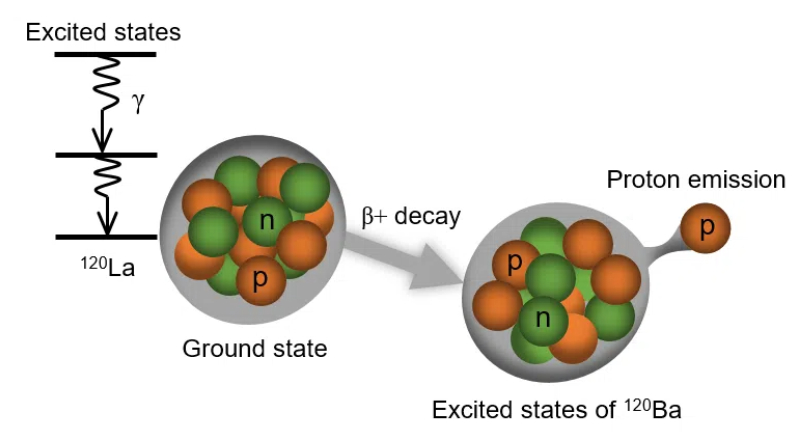Physicists Observe Excited States in Lanthanum-120
For the first time, physicists have observed excited states in the very neutron-deficient odd-odd nucleus, lanthanum-120. The results have been published in Physics Letters B.
This study was conducted by researchers from the Institute of Modern Physics (IMP) of the Chinese Academy of Sciences (CAS), and their collaborators from France, Finland, South Africa and other countries.
As medium-heavy nuclei approach the N=Z line, it is predicted that the proton-neutron interaction will be enhanced, having a measurable impact on the structure of excited states. This may also be accompanied by shape changes of nuclei, which exhibit non spherical shapes, such as "rugby ball" (prolate), “pancake” (oblate), “pear” (octupolar), or “kiwi” (triaxial) shapes.
Lanthanum-120 is a rare β-delayed proton emitter discovered in 1984. Due to its extremely low production cross-section, separating and identifying lanthanum-120 has posed a great challenge. Over the past 40 years, experimental physicists have not been able to successfully measure the excited states of lanthanum-120.
“It is therefore crucial to experimentally measure the excited states to explore the underlying mechanism of the structure evolution in the extremely proton-rich lanthanum nuclei,” said LV Bingfeng, an associate professor at IMP and the corresponding author of the paper.
The researchers utilized a state-of-the-art setup composed of a mass separator and high-efficiency gamma detector arrays to search for the excited states in lanthanum-120, at the accelerator laboratory of the University of Jyvaskyla, Finland.
The researchers then established the level structure of lanthanum-120. They found that the spin at which the energies of odd- and even-spin cascades of gamma rays of lanthanum-120 are crossing follows the systematic trend. Moreover, they discovered that the transition probabilities exhibit a strikingly different pattern, with a significant staggering between odd and even spins, which is distinct from neighboring nuclei.
“Our data, combined with theoretical models, suggest that lanthanum-120 exhibits a pronounced triaxial deformation. The study also indicates that the proton-neutron interaction plays an essential role in describing the structure of odd-odd nuclei close to the proton drip line in the A≈120 mass region,” said Costel Petrache, the corresponding author of the paper from the University of Paris-Saclay in France.
This work was supported by the National Natural Science Foundation of China, the Hubert Curien Partnership “Cai Yuanpei Project”, the International Partnership Program of CAS for Future Network, and the National Research Foundation of South Africa, among others.

Figure 1. (a) Schematic drawing of the experimental setup. (b) Level scheme of lanthanum-120 obtained in the present experiment. (Image from Physics Letters B)

Figure 2. The deexcition and decay mode of lanthanum-120. (Image by LV Bingfeng)
DOI: https://doi.org/10.1016/j.physletb.2024.138806
Contact:
LIU Fang
Institute of Modern Physics
Email: fangliu@impcas.ac.cn
Contact Information
Email: fangliu@impcas.ac.cn
Reference
Researchers at IMP and their collaborators have recently conducted experimental research on laser cooling and precision laser spectroscopy of Li-like oxyge ion beams.



 甘公网安备 62010202000713号
甘公网安备 62010202000713号


